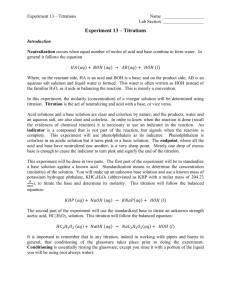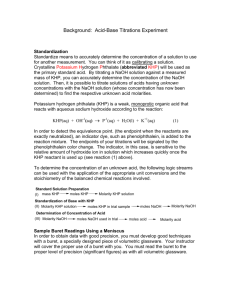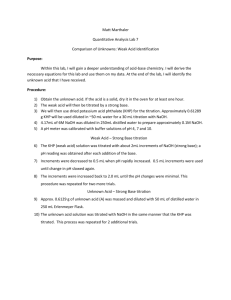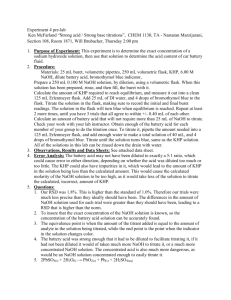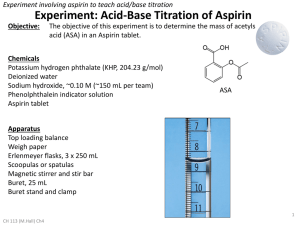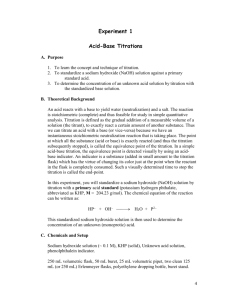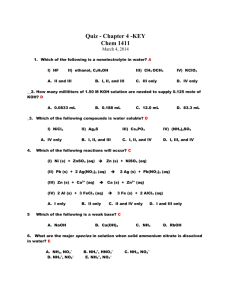Titration Lab Experiment: NaOH Standardization & Acetic Acid
advertisement
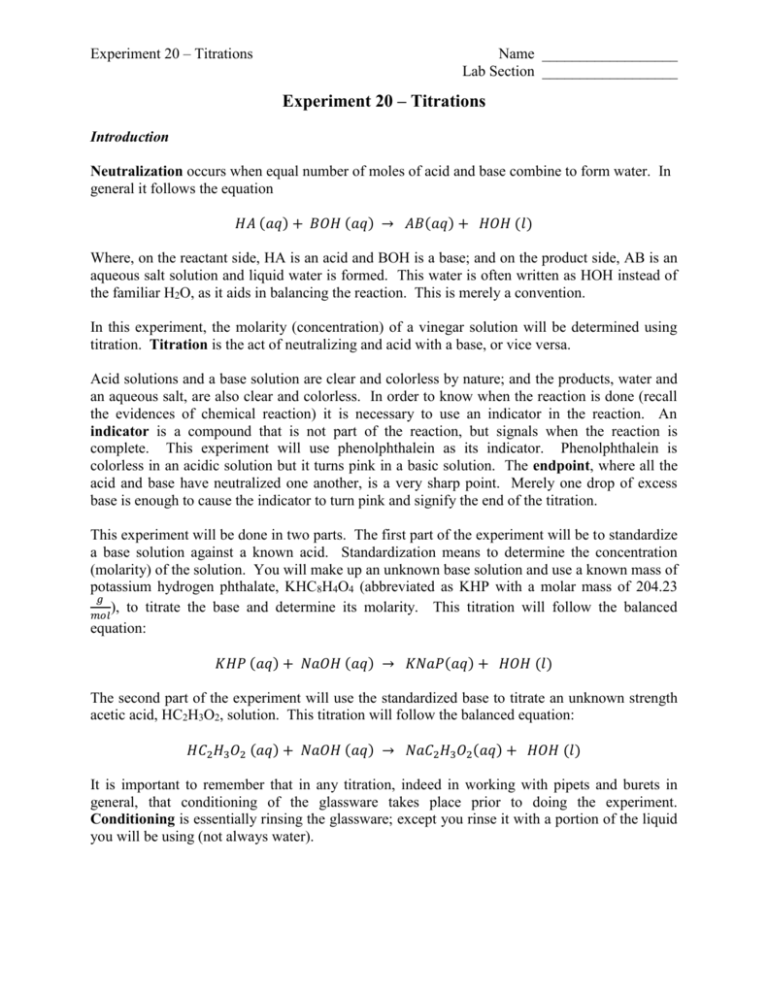
Experiment 20 – Titrations Name __________________ Lab Section __________________ Experiment 20 – Titrations Introduction Neutralization occurs when equal number of moles of acid and base combine to form water. In general it follows the equation 𝐻𝐴 (𝑎𝑞) + 𝐵𝑂𝐻 (𝑎𝑞) → 𝐴𝐵(𝑎𝑞) + 𝐻𝑂𝐻 (𝑙) Where, on the reactant side, HA is an acid and BOH is a base; and on the product side, AB is an aqueous salt solution and liquid water is formed. This water is often written as HOH instead of the familiar H2O, as it aids in balancing the reaction. This is merely a convention. In this experiment, the molarity (concentration) of a vinegar solution will be determined using titration. Titration is the act of neutralizing and acid with a base, or vice versa. Acid solutions and a base solution are clear and colorless by nature; and the products, water and an aqueous salt, are also clear and colorless. In order to know when the reaction is done (recall the evidences of chemical reaction) it is necessary to use an indicator in the reaction. An indicator is a compound that is not part of the reaction, but signals when the reaction is complete. This experiment will use phenolphthalein as its indicator. Phenolphthalein is colorless in an acidic solution but it turns pink in a basic solution. The endpoint, where all the acid and base have neutralized one another, is a very sharp point. Merely one drop of excess base is enough to cause the indicator to turn pink and signify the end of the titration. This experiment will be done in two parts. The first part of the experiment will be to standardize a base solution against a known acid. Standardization means to determine the concentration (molarity) of the solution. You will make up an unknown base solution and use a known mass of potassium hydrogen phthalate, KHC8H4O4 (abbreviated as KHP with a molar mass of 204.23 𝑔 ), to titrate the base and determine its molarity. This titration will follow the balanced 𝑚𝑜𝑙 equation: 𝐾𝐻𝑃 (𝑎𝑞) + 𝑁𝑎𝑂𝐻 (𝑎𝑞) → 𝐾𝑁𝑎𝑃(𝑎𝑞) + 𝐻𝑂𝐻 (𝑙) The second part of the experiment will use the standardized base to titrate an unknown strength acetic acid, HC2H3O2, solution. This titration will follow the balanced equation: 𝐻𝐶2 𝐻3 𝑂2 (𝑎𝑞) + 𝑁𝑎𝑂𝐻 (𝑎𝑞) → 𝑁𝑎𝐶2 𝐻3 𝑂2 (𝑎𝑞) + 𝐻𝑂𝐻 (𝑙) It is important to remember that in any titration, indeed in working with pipets and burets in general, that conditioning of the glassware takes place prior to doing the experiment. Conditioning is essentially rinsing the glassware; except you rinse it with a portion of the liquid you will be using (not always water). Experiment 20 – Titrations Name __________________ Lab Section __________________ Examples 1) A 1.125 g sample of KHP is dissolved in 50 mL of water and titrated with NaOH. The initial buret reading is 1.10 mL and the final reading is 27.55 mL. What is the molarity of the NaOH solution? Recall the chemical equation: 𝐾𝐻𝑃 (𝑎𝑞) + 𝑁𝑎𝑂𝐻 (𝑎𝑞) → 𝐾𝑁𝑎𝑃(𝑎𝑞) + 𝐻𝑂𝐻 (𝑙) 1 mol KHP 1 mol NaOH 1 1.125 g KHP [204.23 g KHP] [ 1 mol KHP ] [0.02645 L NaOH] = 0.20826 M NaOH → 0.208 MNaOH (Note: the volume is the final volume of base minus the initial volume of base, and that is converted to liters to determine molarity.) 2) A 25.0 mL sample of HC2H3O2 is titrated with 0.310 M NaOH. If it takes 20.50 mL to reach the endpoint, what is the concentration of HC2H3O2? 𝐻𝐶2 𝐻3 𝑂2 (𝑎𝑞) + 𝑁𝑎𝑂𝐻 (𝑎𝑞) → 𝑁𝑎𝐶2 𝐻3 𝑂2 (𝑎𝑞) + 𝐻𝑂𝐻 (𝑙) 0.310 𝑚𝑜𝑙 𝑁𝑎𝑂𝐻 0.02050 L NaOH 𝐿 𝑁𝑎𝑂𝐻 [ 1 ][ 1 mol 𝐻𝐶2 𝐻3 𝑂2 1 mol NaOH 1 ] [0.0250 L 𝐻𝐶 2 𝐻3 𝑂2 ] = 0.2542 M 𝐻𝐶2 𝐻3 𝑂2 → 0.254 M 𝑯𝑪𝟐 𝑯𝟑 𝑶𝟐 𝑔 𝑔 If the density of HC2H3O2 is 1.01 𝑚𝐿 and the molar mass is 60.06 𝑚𝑜𝑙, what is the %HC2H3O2 of the solution? (remember your definitions of molarity and density) 0.254 𝑚𝑜𝑙 𝐻𝐶2 𝐻3 𝑂2 𝑠𝑜𝑙𝑢𝑡𝑒 60.06 𝑔 𝐻𝐶2 𝐻3 𝑂2 𝑠𝑜𝑙𝑢𝑡𝑒 1000 𝑚𝐿 𝐻𝐶2 𝐻3 𝑂2 [ 𝑠𝑜𝑙𝑢𝑡𝑖𝑜𝑛 1 mol 𝐻𝐶 2 𝐻3 𝑂2 1 mL 𝐻𝐶 𝐻3 𝑂2 𝑠𝑜𝑙𝑢𝑡𝑖𝑜𝑛 2 ] [ 1.01 g 𝐻𝐶 𝑠𝑜𝑙𝑢𝑡𝑒 2 𝐻3 𝑂2 𝑠𝑜𝑙𝑢𝑡𝑒 = 1.51042 % 𝐻𝐶2 𝐻3 𝑂2 → 1.51 % 𝑯𝑪𝟐 𝑯𝟑 𝑶𝟐 ] x 100% Experiment 20 – Titrations Name __________________ Lab Section __________________ Prelaboratory Questions 1) Please define the following: Indicator Titration Neutralization Endpoint Conditioning Standardization 2) A 50.0 mL sample of phosphoric acid, H3PO4, is titrated with 42.50 mL of 0.250 M NaOH. What is the molarity of the acid? 𝑔 3) Assuming the density of the phosphoric acid is 1.07𝑚𝐿, what is the % H3PO4 of the solution? Experiment 20 – Titrations Name __________________ Lab Section __________________ Procedure Standardization of the Base Prepare your base solution by adding approximately 25 mL of 6 M NaOH to a Florence Flask. Use a large beaker to measure between 500 and 600 mL of DI water and add this to the Florence flask to dilute the base. Be sure to keep the base stoppered when not in use. Place an Erlenmeyer flask on the balance and tare (zero) the balance. Weigh between 0.7 and 1 g of KHP into the Erlenmeyer flask. Dissolve the KHP in approximately 25 mL of DI water. If crystals adhere to the side of the flask, rinse them down into the solution using a squirt bottle. Add 2-3 drops of phenolphthalein to the KHP solution. Condition a buret with your base solution. Fill the buret until the meniscus reads between 0 and 3 mL. Record this initial volume of base. Place the KHP solution on top of a white sheet of paper under the buret. This will aid in the detection of the color change of phenolphthalein. Titrate the KHP solution with your NaOH solution until the solution turns a faint pink. Record the final volume of base. 𝑔 Calculate the molarity of your base. Note: the molar mass of KHP is 204.23 𝑚𝑜𝑙. Repeat these steps until three molarities are all within 0.005 M of one another. Titration of Acetic Acid Obtain 50 mL of an unknown strength acetic acid solution in a clean, dry, 50 mL beaker from your instructor and record its number. Condition a 10.0 mL pipet with the unknown solution. Transfer 10.0 mL of the solution into an Erlenmeyer flask. Add 20-25 mL of deionized water to the flask. Add 2-3 drops of phenolphthalein to the KHP solution. Condition the buret with your NaOH solution. Fill the buret until the meniscus reads between 0 and 3 mL. Record this initial volume of base. Place the acetic acid solution on top of a white sheet of paper under the buret. This will aid in the detection of the color change of phenolphthalein. Titrate the acetic acid solution with your NaOH solution until the solution turns a faint pink. Record the final volume of base. Repeat these steps two more times for reproducibility. Experiment 20 – Titrations Name __________________ Lab Section __________________ Data Table Standardization of NaOH Trial 1 Trial 2 Trial 3 Trial 4 Trial 5 Mass of KHP _________ _________ _________ _________ _________ Final buret reading _________ _________ _________ _________ _________ Initial buret reading _________ _________ _________ _________ _________ Volume of NaOH _________ _________ _________ _________ _________ Calculate the molarity of the NaOH for each trial: Calculated Molarity Trial 1 Trial 2 Trial 3 Trial 4 Trial 5 ________ ________ ________ ________ ________ Average Molarity _______M Experiment 20 – Titrations Name __________________ Lab Section __________________ Data Table Standardization of Acetic Acid Trial 1 Trial 2 Trial 3 Volume of Acetic Acid _________ _________ _________ Final buret reading _________ _________ _________ Initial buret reading _________ _________ _________ Volume of NaOH _________ _________ _________ Calculate the molarity of the acetic acid for each trial, the average molarity, and the average % 𝑔 acetic acid (the density of acetic acid is: 1.01 𝑚𝐿 ): Calculated Molarity Average Molarity ________ Trial 1 Trial 2 Trial 3 ________ ________ ________ Average % Acetic Acid ________ Experiment 20 – Titrations Name __________________ Lab Section __________________ Postlaboratory Questions 1) An extra strength antacid tablet contains 750 mg of active ingredient, CaCO3. If it takes 22.25 mL of HCl to neutralize the tablet, how strong is the acid? 2 𝐻𝐶𝑙 (𝑎𝑞) + 𝐶𝑎𝐶𝑂3 (𝑎𝑞) → 𝐶𝑎𝐶𝑙2 (𝑎𝑞) + 𝐻𝑂𝐻 (𝑙) + 𝐶𝑂2 (𝑔) 2) A beaker containing 25.0 mL of 0.360 M H2SO4 spills on the counter. How much baking soda, NaHCO3 will be needed to neutralize the acid? 𝐻2 𝑆𝑂4 (𝑎𝑞) + 2 𝑁𝑎𝐻𝐶𝑂3 (𝑎𝑞) → 𝑁𝑎2 𝐶𝑂3 (𝑎𝑞) + 2 𝐻𝑂𝐻 (𝑙) 3) If a 35.75 mL sample of 0.175 M HCl solution is neutralized with 0.125 M Mg(OH)2, how much Mg(OH)2 will be needed 𝐻𝐶𝑙 (𝑎𝑞) + 𝑀𝑔(𝑂𝐻)2 (𝑎𝑞) → 𝑀𝑔𝐶𝑙2 (𝑎𝑞) + 2 𝐻𝑂𝐻 (𝑙)

